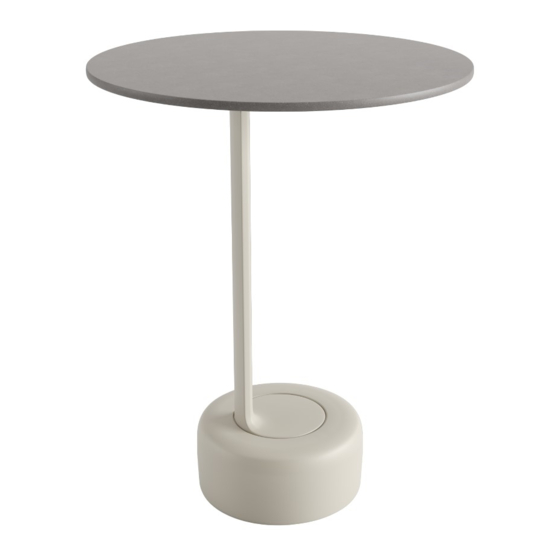arper OELL Panduan Memulai Cepat - Halaman 4
Jelajahi secara online atau unduh pdf Panduan Memulai Cepat untuk Perabotan Dalam Ruangan arper OELL. arper OELL 7 halaman.

environmental impact.
Maintenanace: Dust and the most common stains can be removed
using a well-diluted solution of water and neutral soap. It is
absolutely necessary not to use commercial stain removers for
cleaning. To avoid scratching, use a soft cloth and clean with
gentle, circular movements (especially the opaque finishes, if
subjected to action that is too aggressive, may develop shiny
halos in spots). Do not use waxes for furniture or floors, solvents
or abrasive products. Always dry the surfaces with a dry cloth. Do
not use the pressure washer or high-pressure water, which may
damage the surface of the wood. In case of doubt, test the
cleaning solution on a part hidden from view to verify the result,
waiting at least 24 hours for any problems to arise. Immediately
remove any liquids spilled on the surface of the wood, avoid the
accumulation of water or other liquids that could damage the
product.
Wood can have impurities and imperfections, which fall within
accepted quality standards, and should be considered as
distinctive features that attest to its natural beauty. Periodic and
correct maintenance extends the life of the product.
Plastic Materials:
Regularly plastic surfaces dust using a microfibre cloth. Dust and
common domestic stains can be removed using a cloth or sponge
that has been dampened in tepid water or water with some well-
diluted neutral detergent in it.
Do not use commercial stain removers or aggressive products for
cleaning. In order to avoid scratching the products, use a soft cloth
and clean using circular movements. Under no circumstances
should you use solvent-based detergents or abrasive products. If
you have any doubts, test the cleaning product on a discreet area
in order to check its effect. Wait for at least 24 hours to see if any
problems arise.
Chrome-plated, anodised or painted metal surfaces:
Clean using specific products such as regular detergents for
domestic surfaces diluted in tepid water, provided they are not
abrasive and do not contain acid or bleach. Avoid using sponges
and scourers made from synthetic fibre or metal as these could
permanently mark surfaces. After cleaning, rinse products care-
fully to prevent traces of detergent from reacting with the surface
finish to avoid dulling or oxidisation. After cleaning, dry with a
shammy cloth. The use of polish on chrome-plated or painted
surfaces is not recommended. These products should always be
used with caution and only be experts as their abrasive qualities
could irreparably damage surfaces. If you have any doubts, test
the cleaning product on a discreet area in order to check its effect.
Wait for at least 24 hours to see if any problems arise.
Care instructions
Stainless steel:
Clean on a regular basis (every 15-20 days) using a soft damp
cloth or common products specific for stainless steel.
Table Tops:
Clean and remove any substance that accidentally comes into
contact with the surface as quickly as possible using a damp cloth
or microfibre cloth and some neutral detergent diluted in tepid
water. Always dry after cleaning. Aggressive detergents containing
bleach or abrasive detergents (such as bathroom cream cleaner)
must never be used. Take care not to rub too hard in order to
avoid scratching the surface. Avoid using sponges or scourers
made from synthetic fibres or metal.
If you have any doubts, test the cleaning product on a discreet
area in order to check its effect. Wait for at least 24 hours to see if
any problems arise.
Glass surfaces
The tempered glass used by Arper ensures high levels of safety.
In the event of a breakage, the glass smashes into tiny, rounded
fragments which will not cause a cut. In any case, you should
avoid hitting the glass with hard or sharp objects and the glass
should not be exposed to extreme shifts in temperature (i.e. do not
place very hot or cold items on it).
Regularly dust glass using a microfibre cloth. Clean using specific
products or neutral soap applied using a soft, clean cloth. Do not
used powered detergents or abrasive detergents that could
scratch the glass, causing irrevocable damage to the surface. If
you have any doubts, test the cleaning product on a discreet area
in order to check its effect. Wait for at least 24 hours to see if any
problems arise.
Marble surfaces:
Clean and remove any substance that accidentally comes into
contact with the surface as quickly as possible using a damp cloth
or microfibre cloth and some tepid water or a specialist detergent.
Always dry immediately after cleaning. Take care not to rub too
hard in order to avoid scratching the marble. If you have any
doubts, test the cleaning product on a discreet area in order to
check its effect. Wait for at least 24 hours to see if any problems
arise.
Marble is a calcareous, porous material that is susceptible to
reactions with acidic substances. Marble can absorb fatty or oily
substances and colourants. These can soak into the material and
stain the surface. During use, you are advised against using
objects that can scratch or cause abrasions to the surface, such
as acidic products (Coca Cola, vinegar, acidic detergents) and
colourants (wine, coffee, fruit, sugary liquid, tomato sauce, very
hard water etc.).
